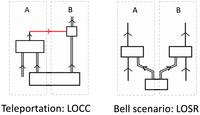Abstract
 A standard approach to quantifying resources is to determine which
operations on the resources are freely available and to deduce the
ordering relation among the resources that these operations induce. If
the resource of interest is the nonclassicality of the correlations
embodied in a quantum state, that is, entanglement, then it is typically
presumed that the appropriate choice of free operations is local
operations and classical communication (LOCC). We here argue that, in
spite of the near-universal endorsement of the LOCC paradigm by the
quantum information community, this is the wrong choice for one of the
most prominent applications of entanglement theory, namely, the study of
Bell scenarios. The nonclassicality of correlations in such scenarios,
we argue, should be quantified instead by local operations and shared
randomness (LOSR). We support this thesis by showing that various
perverse features of the interplay between entanglement and nonlocality
are merely an artifact of the use of LOCC-entanglement and that the
interplay between LOSR-entanglement and nonlocality is natural and
intuitive. Specifically, we show that the LOSR paradigm (i) provides a
resolution of the "anomaly of nonlocality", wherein partially entangled
states exhibit more nonlocality than maximally entangled states, (ii)
entails a notion of genuine multipartite entanglement that is distinct
from the conventional one and which is free of several of its
pathological features, and (iii) makes possible a resource-theoretic
account of the self-testing of entangled states which simplifies and
generalizes prior results. Along the way, we derive some fundamental
results concerning the necessary and sufficient conditions for
convertibility between pure entangled states under LOSR and highlight
some of their consequences, such as the impossibility of catalysis for
bipartite pure states.
A standard approach to quantifying resources is to determine which
operations on the resources are freely available and to deduce the
ordering relation among the resources that these operations induce. If
the resource of interest is the nonclassicality of the correlations
embodied in a quantum state, that is, entanglement, then it is typically
presumed that the appropriate choice of free operations is local
operations and classical communication (LOCC). We here argue that, in
spite of the near-universal endorsement of the LOCC paradigm by the
quantum information community, this is the wrong choice for one of the
most prominent applications of entanglement theory, namely, the study of
Bell scenarios. The nonclassicality of correlations in such scenarios,
we argue, should be quantified instead by local operations and shared
randomness (LOSR). We support this thesis by showing that various
perverse features of the interplay between entanglement and nonlocality
are merely an artifact of the use of LOCC-entanglement and that the
interplay between LOSR-entanglement and nonlocality is natural and
intuitive. Specifically, we show that the LOSR paradigm (i) provides a
resolution of the "anomaly of nonlocality", wherein partially entangled
states exhibit more nonlocality than maximally entangled states, (ii)
entails a notion of genuine multipartite entanglement that is distinct
from the conventional one and which is free of several of its
pathological features, and (iii) makes possible a resource-theoretic
account of the self-testing of entangled states which simplifies and
generalizes prior results. Along the way, we derive some fundamental
results concerning the necessary and sufficient conditions for
convertibility between pure entangled states under LOSR and highlight
some of their consequences, such as the impossibility of catalysis for
bipartite pure states.
Video of the talk:
My Media Link

